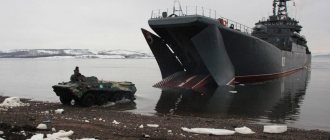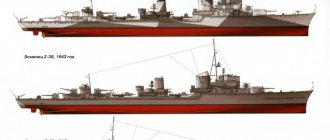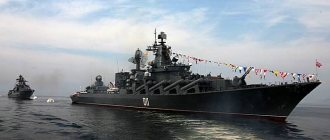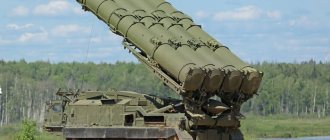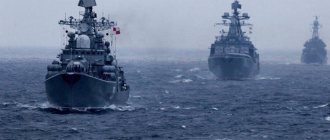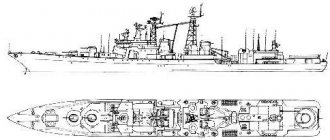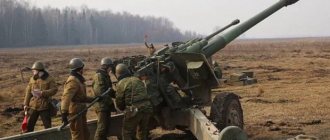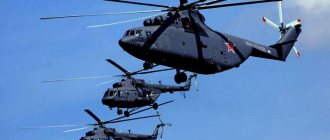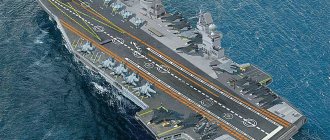History of creation
The creation of coastal troops began at the end of the 17th century, when the regular Russian fleet was being formed. In 1703, the city of St. Petersburg was founded, and then the question of protecting the city from the sea became acute. Fort Kronshlot and the Kronstadt Fortress became the basis of coastal defense.
For the first time in the Russian fleet, a team of marines was formed on the basis of the crew of the sailing ship "Eagle" in 1698. After a successful battle with the Swedish flotilla, on November 27, 1705, Peter I issued a decree on the creation of the first "regiment of naval soldiers."
The regiment had two battalions, each battalion had five companies, and a company had 125 soldiers. Total number of command personnel: 45 staff and chief officers, 70 non-commissioned officers; rank and file - 1250 people. The officers were armed with pistols and swords, and non-commissioned officers and privates used guns with baguettes (prototypes of gun bayonets).
Naval regiments participated with honor in all Russian wars. During the First and Second World Wars, naval soldiers carried out a number of brilliant amphibious operations.
The main tasks of the Coastal Forces of the Navy
Coastal Forces (BC) - a branch of the Navy, designed to cover the forces of fleets, troops, populations and objects on the sea coast from the influence of enemy surface ships; defense of naval bases and other important fleet facilities from land, including from sea and airborne assaults; landings and actions in sea, air and sea landings; assistance to ground forces in anti-landing defense of amphibious assault areas of the sea coast; destruction of surface ships, boats and landing vehicles within the reach of weapons.
Coastal troops include 2 types of troops: coastal missile and artillery troops and marine infantry.
Each branch of the military solves certain target tasks independently and in cooperation with other branches of the military forces and naval forces, as well as with formations and units of other branches of the Armed Forces and branches of the military.
The main organizational units of the military units are brigades and battalions (divisions).
BVs are equipped primarily with weapons and equipment of the combined arms type. They are armed with coastal missile systems (CBM) of anti-ship guided missiles, stationary and mobile artillery installations designed to destroy sea and ground targets, special (marine) reconnaissance equipment, etc.
The current state of the Russian air defense system
I was largely inspired to write this article by the excessive jingoistic sentiments of a significant part of the visitors to the website “Military Review”, which I respect, as well as the slyness of the domestic media, which regularly publish materials about the strengthening of our military power, unprecedented since Soviet times, including the Air Force and Air Defense.
For example, in a number of media outlets, including on “VO”, in the “News” section, a material was recently published entitled: “Two air defense divisions have begun protecting the airspace of Siberia, the Urals and the Volga region.”
Which states: “The Assistant Commander of the Central Military District, Colonel Yaroslav Roshchupkin, stated that two air defense divisions took up combat duty, starting to protect the airspace of Siberia, the Urals and the Volga region.
“The duty forces of two air defense divisions took up combat duty to cover administrative, industrial and military facilities in the Volga region, the Urals and Siberia. The new formations were formed on the basis of the Novosibirsk and Samara aerospace defense brigades,” RIA Novosti quotes him as saying.
Combat crews equipped with S-300PS anti-aircraft missile systems will cover the airspace over the territory of 29 constituent entities of the Russian Federation, which are included in the area of responsibility of the Central Military District.”
After such news, an inexperienced reader may get the impression that our anti-aircraft missile defense units have received qualitative and quantitative reinforcement with new anti-aircraft systems.
In practice, in this case, no quantitative, much less qualitative, strengthening of our air defense happened. It all just comes down to changing the staffing and organizational structure. New equipment did not enter the troops.
The anti-aircraft missile system of the S-300PS modification mentioned in the publication, with all its advantages, cannot in any way be considered new.
S-300PS
The S-300PS with 5V55R missiles was put into service back in 1983. That is, more than 30 years have passed since the adoption of this system. But at present, in air defense anti-aircraft missile units, more than half of the S-300P long-range air defense systems belong to this modification.
In the near future (two to three years), most S-300PS will either have to be written off or overhauled. However, it is not known which option is economically preferable, the modernization of old or the construction of new anti-aircraft systems.
The earlier towed version of the S-300PT has already either been written off or transferred “for storage” without any chance of returning to the troops.
The “freshest” complex from the “three hundredth” family, the S-300PM, was delivered to the Russian army in the mid-90s. Most of the anti-aircraft missiles currently in service were produced at the same time.
The new, widely publicized S-400 anti-aircraft missile system has only just begun to enter service. In total, as of 2014, 10 regimental sets were delivered to the troops. Taking into account the upcoming mass write-off of military equipment that has exhausted its service life, this amount is absolutely insufficient.
S-400
Of course, experts, of whom there are many on the site, can reasonably argue that the S-400 is significantly superior in its capabilities to the systems it is replacing. However, we should not forget that the air attack means of the main “potential partner” are constantly being qualitatively improved. In addition, as follows from “open sources”, mass production of the promising 9M96E and 9M96E2 missiles and the ultra-long-range 40N6E missile has not yet been established. Currently, the S-400 uses 48N6E, 48N6E2, 48N6E3 S-300PM air defense missiles, as well as 48N6DM missiles modified for the S-400.
In total, if you believe “open sources”, our country has about 1,500 S-300 family air defense missile launchers - this, apparently, takes into account those “in storage” and in service with the air defense units of the ground forces.
Today, Russian air defense forces (those that are part of the Air Force and Air Defense) have 34 regiments with S-300PS, S-300PM and S-400 air defense systems. In addition, not long ago several anti-aircraft missile brigades, transformed into regiments, were transferred to the Air Force and Air Defense from the air defense of the ground forces - two 2-divisional brigades of S-300V and Buk and one mixed (two divisions of S-300V , one Buk division). Thus, in the troops we have 38 regiments, including 105 divisions.
However, these forces are distributed extremely unevenly throughout the country; Moscow is best protected, around which ten regiments of S-300P air defense systems are stationed (two of them have two S-400 divisions).
Google Earth satellite image. Layout of air defense missile systems around Moscow. Colored triangles and squares are positions and basing areas of existing air defense systems, blue diamonds and circles are surveillance radars, white are currently eliminated air defense systems and radars.
The northern capital, St. Petersburg, is well covered. The sky above it is protected by two S-300PS regiments and two S-300PM regiments.
Google Earth satellite image. Layout of air defense missile systems around St. Petersburg
The Northern Fleet's bases in Murmansk, Severomorsk and Polyarny are covered by three S-300PS and S-300PM regiments. At the Pacific Fleet in the area of Vladivostok and Nakhodka there are two S-300PS regiments, and the Nakhodka regiment received two S-400 divisions. Avacha Bay in Kamchatka, where the SSBNs are based, is covered by one S-300PS regiment.
Google Earth satellite image. S-400 air defense system in the vicinity of Nakhodka
The Kaliningrad region and the Baltic Fleet base in Baltiysk are protected from air attack by a mixed regiment of S-300PS/S-400.
Google Earth satellite image. S-400 air defense system in the Kaliningrad region at the former positions of the S-200 air defense system
Recently, anti-aircraft cover of the Black Sea Fleet has been strengthened. Before the well-known events related to Ukraine, a mixed regiment with S-300PM and S-400 divisions was stationed in the Novorossiysk area.
Currently, there is a significant strengthening of the air defense of the main naval base of the Black Sea Fleet - Sevastopol. It is reported that in November the peninsula's air defense group was replenished with S-300PM air defense systems. Taking into account the fact that complexes of this type are currently not produced by industry for its own needs, they were apparently transferred from another region of the country.
In terms of air defense cover, the central region of our country resembles a “patchwork quilt” with more holes than patches. There is one S-300PS regiment each in the Novgorod region, near Voronezh, Samara and Saratov. The Rostov region is covered by one S-300PM and a Buk regiment each.
In the Urals near Yekaterinburg there are positions of an anti-aircraft missile regiment armed with S-300PS. Beyond the Urals, in Siberia, on a gigantic territory, only three regiments are stationed, one S-300PS regiment each near Novosibirsk, in Irkutsk and Achinsk. In Buryatia, not far from the Dzhida station, one regiment of the Buk air defense system is stationed.
Google Earth satellite image. S-300PS air defense system near Irkutsk
In addition to the anti-aircraft systems protecting fleet bases in Primorye and Kamchatka, in the Far East there are two more S-300PS regiments, covering Khabarovsk (Knyaze-Volkonskoe) and Komsomolsk-on-Amur (Lian) respectively; one S-300PS regiment is deployed in the vicinity of Birobidzhan 300V.
That is, the entire huge Far Eastern Federal District is protected by: one mixed S-300PS/S-400 regiment, four S-300PS regiments, one S-300V regiment. This is all that remains of the once powerful 11th Air Defense Army.
The “holes” between air defense facilities in the east of the country are several thousand kilometers long, and anyone and anything can fly into them. However, not only in Siberia and the Far East, but throughout the country, a huge number of critical industrial and infrastructure facilities are not covered by any air defense systems.
In a significant part of the country, nuclear and hydroelectric power plants remain unprotected, and air strikes on them could lead to catastrophic consequences. The vulnerability of Russian strategic nuclear forces deployment sites to air attacks provokes “potential partners” to attempt a “disarming strike” with high-precision weapons to destroy non-nuclear weapons.
In addition, long-range air defense systems themselves need protection. They need to be covered from the air by short-range air defense systems. Today, regiments with the S-400 receive Pantsir-S air defense missile systems for this (2 per division), but the S-300P and B are not covered by anything, except, of course, for the effective protection of 12.7 mm anti-aircraft machine gun mounts.
"Pantsir-S"
The situation with airborne lighting is no better. This should be done by the radio technical troops; their functional responsibility is to provide advance information about the beginning of an enemy air attack, provide target designation for anti-aircraft missile forces and air defense aviation, as well as information for controlling formations, units and air defense units.
During the years of “reforms,” the continuous radar field formed during the Soviet era was partially, and in some places completely lost. At present, there is practically no possibility of monitoring the air situation over the polar latitudes.
Until recently, our political and former military leadership appeared to be preoccupied with other more pressing issues, such as the reduction of the armed forces and the sale of “surplus” military equipment and real estate.
Only recently, at the end of 2014, Defense Minister General of the Army Sergei Shoigu announced measures that should help correct the existing situation in this area.
As part of the expansion of our military presence in the Arctic, it is planned to build and reconstruct existing facilities on the New Siberian Islands and Franz Josef Land, it is planned to reconstruct airfields and deploy modern radars in Tiksi, Naryan-Mar, Alykel, Vorkuta, Anadyr and Rogachevo. The creation of a continuous radar field over Russian territory should be completed by 2022. At the same time, it is planned to upgrade radar stations and data processing and transmission facilities by 30%.
Fighter aircraft, designed to combat enemy air attacks and carry out missions to gain air superiority, deserve special mention. Currently, the Russian Air Force formally has (including those in “storage”) about 900 fighters, of which: Su-27 of all modifications - more than 300, Su-30 of all modifications - about 50, Su-35S - 34, MiG -29 of all modifications - about 250, MiG-31 of all modifications - about 250.
It should be taken into account that a significant part of the Russian fighter fleet is included in the Air Force in name only. Many aircraft produced in the late 80s and early 90s require major repairs and modernization. In addition, due to problems with the supply of spare parts and replacement of failed avionics units, some of the modernized fighters are essentially, as aviators put it, “doves of peace.” They can still take to the air, but they can no longer fully complete a combat mission.
The past 2014 was significant for volumes of aircraft supplied to the Russian armed forces, unprecedented since the times of the USSR.
In 2014, our Air Force received 24 multifunctional Su-35S fighters produced by the Yu.A. Aviation Plant. Gagarin in Komsomolsk-on-Amur (branch of JSC "):
Su-35S at Dzyomgi airfield, photo by the author
Twenty of them became part of the recreated 23rd Fighter Aviation Regiment of the 303rd Guards Mixed Aviation Division of the 3rd Russian Air Force and Air Defense Command at the Dzemgi airfield (Khabarovsk Territory) shared with the plant.
All these fighters were built under a contract dated August 2009 with the Russian Ministry of Defense for the construction of 48 Su-35S fighters. Thus, the total number of vehicles manufactured under this contract by the beginning of 2015 reached 34.
The production of Su-30SM fighters for the Russian Air Force is carried out by the Irkut Corporation under two contracts for 30 aircraft each, concluded with the Russian Ministry of Defense in March and December 2012. After the delivery of 18 vehicles in 2014, the total number of Su-30SM delivered to the Russian Air Force reached 34 units.
Su-30M2 at Dzyomgi airfield, photo by the author
Eight more Su-30M2 fighters were produced by the Yu.A. Aviation Plant. Gagarin in Komsomolsk-on-Amur.
Three fighters of this type entered the newly formed 38th Fighter Aviation Regiment of the 27th Mixed Aviation Division of the 4th Russian Air Force and Air Defense Command at the Belbek airfield (Crimea).
The Su-30M2 aircraft were built under a contract dated December 2012 for the supply of 16 Su-30M2 fighters, bringing the total number of aircraft built under this contract to 12, and the total number of Su-30M2s in the Russian Air Force to 16.
However, this quantity, significant by today’s standards, is absolutely insufficient to replace aircraft in fighter regiments that are being written off due to complete physical wear and tear.
Even if the current rate of supply of aircraft to the troops is maintained, according to forecasts, in five years the fighter fleet of the domestic Air Force will be reduced to approximately 600 aircraft.
Over the next five years, about 400 Russian fighters are likely to be retired—up to 40% of the current roster.
This is primarily with the upcoming decommissioning of the old MiG-29 (about 200 units) in the very near future. Due to problems with the airframe, about 100 aircraft have already been rejected.
Su-27SM at Dzyomgi airfield, photo by the author
Unmodernized Su-27s, whose flight life will end in the near future, will also be written off. The number of MiG-31 interceptors will be reduced by more than half. It is planned to retain 30-40 MiG-31s in the DZ and BS modifications in the Air Force, and another 60 MiG-31s will be upgraded to the BM version. The remaining MiG-31s (about 150 units) are planned to be written off.
The shortage of long-range interceptors should be partially resolved after the start of mass deliveries of the PAK FA. It was announced that it is planned to purchase up to 60 PAK FA units by 2020, but for now these are only plans that will most likely undergo significant adjustments.
The Russian Air Force has 15 A-50 AWACS aircraft (another 4 in “storage”), recently supplemented by 3 modernized A-50U. The first A-50U was delivered to the Russian Air Force in 2011.
As a result of the work carried out as part of the modernization, the functionality of the aviation complex for long-range radar detection and control has significantly increased. The number of simultaneously tracked targets and simultaneously guided fighters has been increased, and the detection range of various aircraft has been increased.
The A-50 should be replaced by the A-100 AWACS aircraft based on the Il-76MD-90A with a PS-90A-76 engine. The antenna complex is built on the basis of an antenna with an active phased array.
At the end of November 2014, TANTK named after. G. M. Beriev received the first Il-76MD-90A aircraft for conversion into the A-100 AWACS aircraft. Deliveries to the Russian Air Force are scheduled to begin in 2016.
All domestic AWACS aircraft are permanently based in the European part of the country. Beyond the Urals they appear quite rarely, mostly during large-scale exercises.
Unfortunately, loud statements from high stands about the revival of our Air Force and Air Defense often have little to do with reality. In the “new” Russia, an unpleasant tradition has become an absolute irresponsibility for the promises made by high-ranking civilian and military officials.
As part of the state armament program, it was planned to have twenty-eight 2-divisional regiments of the S-400 and up to ten divisions of the latest S-500 air defense system (the latter should perform the tasks of not only air defense and tactical missile defense, but also strategic missile defense) by 2022. There is now no doubt that these plans will be thwarted. The same fully applies to plans regarding the production of the PAK FA.
However, as usual, no one will suffer serious punishment for disrupting the state program. After all, we “don’t hand over our own,” and “we’re not in 1937,” right?
PS All information given in the article regarding the Russian Air Force and Air Defense was taken from open public sources, a list of which is given. The same applies to possible inaccuracies and errors.
Sources of information: https://rbase.new-factoria.ru https://bmpd.livejournal.com https://geimint.blogspot.ru Satellite images courtesy of Google Earth
Composition of coastal troops of the Russian Navy
Pacific Fleet
- The 72nd missile brigade in Smolyaninovo, designed to defend the main base of the Pacific Fleet, is located in Vladivostok.
- 216th separate electronic warfare regiment in the village. Englishwoman.
- 155 Mozyr Marine Brigade in Vladivostok, it is the basis of the landing forces of the Pacific Fleet.
- 40 Krasnodar-Harbin twice Red Banner MP brigade, located in Petropavlovsk-Kamchatsky.
- 520th missile and artillery brigade (Anglichanka village).
- 140 communication center in Vladivostok.
- 471 and 474 electronic defense centers (in Petropavlovsk-Kamchatsky and the village of Shtykovo).
- 1532 anti-aircraft missile regiment (Petropavlovsk-Kamchatsky).
Black Sea Fleet
The main part of the forces is located in Crimea (Sevastopol):
- 15th missile and artillery brigade.
- 854th Coastal Missile Regiment.
- 127th separate reconnaissance brigade.
- 810 MP Brigade of the Order of Zhukov G.K.
- 529 Red Banner Communications Center.
- 475 electronic warfare center.
- 224th separate control battalion.
- 1096 anti-aircraft missile regiment.
- 4th RCB protection regiment.
In other cities of Crimea:
- 8th Coastal Artillery Regiment in Simferopol.
- 126 Gorlovka coastal defense brigade in the village. Perevalnoye.
- 68th separate naval engineering regiment in Yevpatoria.
- 133rd separate logistics brigade in Bakhchisarai.
In Krasnodar region:
- 382 MP battalion (Temryuk).
- 11th coastal missile and artillery brigade in Anapa.
- Rocket and self-propelled artillery divisions in the village. Vinogradny.
Baltic Fleet
Most of the forces are based in the city of Kaliningrad and the region:
- 336th Guards Bialystok Order of Suvorov and Alexander Nevsky Marine Brigade, located in Baltiysk.
- 7th Guards Motorized Rifle Regiment in Kaliningrad.
- 152nd Guards Rocket Brest-Warsaw Brigade (Chernyakhovsk).
- 244th Artillery Neman Red Banner Brigade (Kaliningrad).
- 25th Marine Missile Regiment (Donskoye village).
- 22nd Guards Anti-Aircraft Missile Regiment (Kaliningrad).
- 742 communication center (Kaliningrad).
- 69th Guards Marine Engineering Mogilev Regiment.
- 46th reconnaissance battalion, Gusev.
- 752 security platoon of the Leningrad naval base located in Kronstadt.
Northern Fleet
- The headquarters of the Northern Fleet BV is located in the city of Severomorsk.
- 211th separate battalion (Olenegorsk).
- Security and escort company of the Military Commandant's Office of the Severomorsk garrison.
- 160, 269 and 313 detachments for combating underwater sabotage forces and means are based in the village. Vidyaevo, Gadzhievo and Sputnik.
- 536 coastal missile and artillery brigade in Snezhnogorsk.
- 63rd Marine Engineering Regiment (Severomorsk, Shchukozero village).
- 61 Kirkenes MP brigade (Sputnik village, Murmansk region), it includes 874 separate marine battalion, 876 separate air assault battalion, 886 separate reconnaissance and landing battalion, 125 separate tank battalion, 1611 and 1591 separate self-propelled artillery divisions, 1617 separate.
Caspian flotilla
The BV forces of the Caspian Flotilla are located in the city of Kaspiysk:
- 177th Marine Regiment.
- 46th Coastal Missile Division.
Armament
Rocket, motorized rifle and artillery units counter sabotage forces and enemy marines using the following weapons and military equipment:
- Tanks T-80 VM, T-72B and T-72B3. The total quantity is at least 250 units.
- BMD-2 tracked amphibious combat vehicles.
- BMP-2 tracked vehicles (400 pieces).
- Floating armored personnel carriers MT-LB (300 units).
- Armored personnel carriers BTR-80 (100 vehicles).
- Russian modernized armored personnel carriers BTR-80A (600 units).
- Artillery missile systems (RK) "Redut".
- Mobile coastal missile systems "Rubezh".
- RK "Bastion" and "Bal" (36 guns each).
- Coastal self-propelled artillery systems A-222 "Bereg" in the amount of 36 units.
- Tactical missile systems "Tochka-U" (12 pcs.).
- Regimental self-propelled howitzers 2S1 “Gvozdika” (95 guns).
- Divisional howitzers 2S3 "Akatsiya" (50 units).
- Self-propelled artillery mounts 2S19 “Msta-S” and “Nona-S” 2S9, 18 and 30 pcs. The Russian BV also has 12 modernized Nona-SVK2S23 self-propelled gun mounts.
Coastal defense personnel also have Uragan and Grad 9K51 multiple launch rocket systems, 2B14 Tray mortars, and Khrizantema-S, Shturm-S, Konkurs, and Kornet anti-tank weapons.
Air defense is carried out by military personnel of the Coastal Forces using the following types of army equipment:
- Man-portable anti-aircraft missile systems "Igla-S".
- Self-propelled anti-aircraft guns "Shilka" in the amount of 60 guns.
- SAM systems "Strela-1" and "Strela-10", the total number of which is 50 units.
- Anti-aircraft missile and gun systems "Tunguska" and "Pantsir-S1".
In addition, the Coastal Forces are equipped with unmanned aerial vehicles, vehicles, all-terrain vehicles and engineering equipment.
The material was published in the magazine “Arsenal of the Fatherland” No. 6(26) for 2016.
Alexey Leonkov
The Russian Federation is the only country in the world that has a full-scale, layered, integrated aerospace defense system. The technical basis of aerospace defense are complexes and systems of air defense and missile defense, designed to solve all types of problems: from tactical to operational-strategic. The technical parameters of aerospace defense complexes and systems make it possible to organize reliable cover for troops, the most important public administration facilities, industry, energy and transport.
2016 turned out to be a “fruitful” year for news about air defense systems that are entering service within the framework of the State Armament Program (GPV-2020). Many experts and military specialists call them the best among existing air defense systems. The Russian aerospace defense concern Almaz-Antey, the lead developer and manufacturer of aerospace defense complexes and systems, does not rest on its laurels; it has begun developing fifth-generation anti-aircraft missile systems and is creating a scientific and technical foundation for the future. In 2016, the Arsenal of the Fatherland magazine devoted a number of articles to the topic of air defense, starting with the history of its creation (see “Military Academy in the 100-year history of military air defense” in No. 1 (21) 2016), spoke about the basics of the combat use of military air defense (see “Military air defense: basics of combat use” in No. 4 (24) 2016) and military air defense systems of the world’s armies (see “Military air defense systems of the world’s armies” in No. 3 (23) 2016). Such attention is paid to this type of defense for a reason. The fact is that, within the framework of the Military Doctrine adopted in 2008, air defense systems and complexes occupy one of the key places in the defense construction and modernization of the Russian army. Interim results of building a modern layered air defense were discussed at the XXIV Military Scientific Conference of Military Air Defense, held in May 2016 in Smolensk. The report of the head of the military air defense of the RF Armed Forces, Lieutenant General Leonov A.P. “Development of the theory and practice of using military air defense of the Armed Forces of the Russian Federation in modern conditions,” noted that the combat potential of military air defense has increased significantly with the supply of the latest highly effective anti-aircraft missile systems and complexes. These are, first of all, the S-300V4 air defense system, the Buk-M2/M3 air defense system and the Tor-M2/M2U air defense system. These systems differ from their predecessors in higher noise immunity and effectiveness in defeating various air attack weapons (AEA), multi-channel, increased rate of fire and increased ammunition capacity of anti-aircraft missiles. Doctor of Military Sciences, Lieutenant General A. D. Gavrilov, in the article “Military Air Defense: Fundamentals of Combat Use,” noted the following: “No matter how highly effective technical means the air defense system possesses, the achievement of the assigned tasks is achieved by the skillful combat use of formations, units and subunits in battle and operations. The entire 100-year history of the existence of military air defense testifies to the high level of professionalism of commanders and staffs, the awareness of personal responsibility of each anti-aircraft gunner for the assigned task of protecting the peaceful sky.” The development and production of highly efficient equipment in parallel with participation in the training of personnel of military air defense units is a distinctive feature of the practical work of the Russian defense association - the Almaz-Antey Aerospace Defense Concern.
Results of the work of Almaz-Antey
In November 2016, Almaz-Antey summed up the results of the year. As part of the fulfillment of state defense orders (GOZ), the Ministry of Defense received five regiments of the S-400 Triumph air defense system, three divisions of the Buk-M2 medium-range air defense system, four divisions of the Tor-M2 short-range air defense system, a brigade set of the latest Buk-M2 air defense systems. M3", as well as a number of different radars. In addition, in the past year, Almaz-Antey specialists carried out the necessary service activities for the maintenance and repair of more than two thousand weapons, military and special equipment (VVST) previously transferred to the Armed Forces of the Russian Federation, and also supplied simulators for training combat crews of the complexes Air defense. “Already, the annual targets for the supply of basic weapons have been completed by 70 percent, and for the purchase of missiles and ammunition - by more than 85 percent. The troops received over 5.5 thousand units of weapons and military equipment, including more than 60 new and 130 modernized airplanes and helicopters, a multipurpose submarine, more than 60 anti-aircraft missile systems and complexes, 55 radar stations, 310 new and 460 modernized tanks and armored vehicles,” Supreme Commander-in-Chief, President of Russia Vladimir Vladimirovich Putin noted in his speech at a meeting with the leadership of the Russian Ministry of Defense, federal departments and defense industry enterprises, which took place on November 15, 2016 in Sochi. At the same meeting, the Concern’s contribution to ensuring the security of the Khmeimim airbase and the Tartus naval base was noted, after the deployment of the S-400 air defense system and the S-300V4 air defense system. According to the Russian Minister of Defense, Army General Sergei Kuzhugetovich Shoigu, these systems reliably protect our bases in Syria both from sea and from land. In addition, the Concern’s specialists restored the Syrian S-200 air defense systems. The concern continued work on supplying the troops with the modernized and latest air defense systems of the S-300V4 air defense system, the Buk-M3 air defense system and the Tor-M2U air defense system. Without going into listing the technical characteristics of these complexes, we will briefly highlight their key features.
S-300V4 air defense system This air defense system is a deep modernization of the S-300 complex, the production of which has been carried out by the enterprises of the Almaz-Antey Aerospace Defense Concern since 1978. The heavy 9M83VM missile of the modernized S-300V4 is capable of reaching a speed of Mach 7.5 and can hit air targets at a distance of up to 400 kilometers. The “small” missile has a range of up to 150 km. The destruction of all existing and future aerospace attack weapons is ensured, including tactical ballistic missiles (at a range of up to 200 km). In general, the combat effectiveness of the S-300V4 has increased by 2.3 times compared to previous generations of the S-300. Another feature of the system is increased mobility. Elements of the S-300V4 are placed on a tracked chassis, which allows for maneuver and deployment in the operational formation of formations, marching and combat formation of Ground Forces formations off roads, on rough terrain. The anti-aircraft missile division is capable of simultaneously firing at up to 24 targets, aiming 48 missiles at them. The rate of fire of each launcher is 1.5 seconds. The entire complex is transferred from standby mode to combat mode in 40 seconds, and the deployment time from the march takes 5 minutes. The battalion's ammunition load is 96–192 anti-aircraft missiles. According to data from open sources, one of the first S-300V4s was received by the recently formed 77th separate anti-aircraft missile brigade of the Southern Military District, based in the Krasnodar Territory. In the fall of 2016, the S-300V4 air defense system was relocated to Syria to the Khmeimim airbase to strengthen the air defense potential of the Russian Aerospace Forces group.
SAM Buk-M3 The Buk-M3 target acquisition station (STS) now tracks up to 36 targets at a distance of up to 70 kilometers across the entire altitude range. The new 9R31M (9M317M) missile has higher speed and maneuverability characteristics compared to the Buk-M2 missiles. It is placed in a transport and launch container (TPC), which provides additional protection for the missile and improves the camouflage characteristics of the launcher. The number of missiles on one launcher has increased from 4 to 6. In addition, 9A316M transport-launchers can also hit targets; they carry 12 missiles in a TPK. The Buk-M3 equipment is built on a new element base; digital communications ensure a stable exchange of voice and combat information, as well as integration into the air defense technical control system. The Buk-M3 air defense system intercepts almost all modern air defense systems that fly at speeds of up to 3000 m/s, thereby exceeding the capabilities of the Patriot air defense system (USA) by almost two times. In addition, the “American” is inferior to the “Buk” in terms of the lower limit of target fire (60 meters versus 10 meters) and in the duration of the target detection cycle at distant approaches. The Buk-M3 can do this in 10 seconds, and the Patriot in 90 seconds, while requiring target designation from a reconnaissance satellite.
Tor-M2U air defense missile system Tor -M2U short-range air defense missile systems effectively destroy targets flying at extremely low, low and medium altitudes at speeds of up to 700 m/s, including in conditions of a massive air attack and active counteraction to enemy electronic warfare. The complex's SOC can detect and track up to 48 targets at a range of up to 32 kilometers. The complex's launcher can simultaneously fire at 4 targets at an azimuth of 3600, i.e., all around. A special feature of the Tor-M2U air defense system is the fact that it can conduct combat work on the move, at speeds of up to 45 km/h. Modern Tora equipment automatically identifies the ten most dangerous targets, and the operator only has to give the command to defeat them. Moreover, our newest Tor-M2U detects aircraft created using stealth technology. The Tor-M2U air defense system battery consists of six launchers that can exchange combat information with each other automatically. Thus, by receiving information from one launcher, the others can repel a massive air attack from any direction. Retargeting time takes no more than 5 seconds.
Reaction of Western “partners” to the development of Russian aerospace defense The successes of Russian air defense, exploiting the products of the Almaz-Antey Aerospace Defense Concern, have long worried the minds of military leaders of NATO countries. In the early 2000s, they did not believe that Russia would be able to create effective air defense systems and continued to purchase “reliable and time-tested” air attack weapons (AEA) from their countries’ defense industry enterprises. The development of new aviation systems, such as the fifth-generation fighter F-35 and the promising B-21 bomber, proceeded at a leisurely pace. The first alarming signals for NATO sounded after 2010, when the revival of Russia’s military power began. Since 2012, military exercises began to occur much more frequently, and new military air defense systems were actively involved in these exercises. They regularly hit complex, high-speed and maneuvering targets with 100% results, at maximum ranges and without the use of additional target designation equipment. Thanks to the S-400 and S-300V4 air defense systems, the long-range line of destruction at the operational-tactical level has increased to 400 kilometers, which means that modern and promising air defense systems of NATO countries are guaranteed to fall into the firing zone of Russian air defense systems. NATO generals sounded the alarm. At the same time, purely defensive air defense systems were characterized in the Western media as “means of aggression.” True, there were also more pragmatic assessments. In 2015, American military expert Tyler Rogoway discussed the topic of countering Russian air defense systems on his Foxtrot Alpha blog. In particular, he paid a lot of attention to working at a safe distance beyond the reach of destructive weapons: “The capabilities of air defense detection devices (Russian - author’s note) are only getting better, just as the range of destruction of surface-to-air missiles is growing.” Therefore, it may be necessary to use long-range stealth missiles combined into one information network. Or long-range stealth aircraft and other techniques, including suppression (at a distance), to weaken and ultimately destroy the air defense system. As a result, working outside the range of enemy weapons, you can weaken his air defense. Then, for example, you can fly closer and use a fighter with medium-range stealth missiles, instead of launching long-range missiles. At the same time, regular (non-stealth) aircraft can attack with long-range missiles, thus freeing up space for the stealth aircraft to attack. And drones, decoys with electronic warfare equipment on board, can be used together with attacking combat units to delve deeper into enemy territory, disabling air defense systems along the way.” In addition to the widespread use of “stealth technologies,” the Americans are relying on electronic warfare and electronic warfare systems. For example, the US Navy is working to develop a method to counter modern air defense systems with phased array radars, such as the S-400 or the Chinese FD-2000 air defense system. They are going to equip EA-18G Growler aircraft (a carrier-based electronic warfare aircraft based on the F/A-18 Super Hornet) with Next Generation Jammer (NGJ) electronic countermeasures systems. It is assumed that such electronic warfare systems will allow American strike aircraft to destroy enemy targets without the risk of being noticed by anti-aircraft missile systems, the American magazine The National Interest reported in October 2016. The development of a new version of NGJ is being carried out by Raytheon, which has already received a contract from the US Department of Defense for one billion dollars. American experts believe that the electronic warfare system will be able to jam signals at any frequencies in which the phased array operates, and that this will be enough to be able to freely attack Russian systems Air defense. According to plans, the NGJ should enter service in 2022. In the next 5–10 years, the military-industrial complex of NATO countries intends to develop means of overcoming and suppressing our air defense systems. However, the scientific and technical groundwork implemented in air defense systems by the enterprises of the Almaz-Antey Aerospace Defense Concern makes it possible to neutralize the efforts of Western specialists.
Prospects for the development of Russian air defense systems Fourth generation of air defense automated control systems Currently, automated control systems for troops (ATCS), air defense forces and means (Air Defense ACS) are at the fourth technological stage of development. In conditions of the rapidity of enemy air defense attacks, modern air defense cannot be effective without automated systems for controlling forces and means. This stage of rearmament is taking place in the context of organizational and staffing changes in the structure of the command and control system of the Russian Armed Forces. Requirements for efficiency, continuity, stability and secrecy of command and control of troops are being tightened, new combat and information means for air defense, air defense, radio and electronic warfare with higher capabilities are being developed and put into service. Enterprises of the Almaz-Antey Aerospace Defense Concern are already supplying the armed forces with systems and complexes that are integrated with automated control systems and ESU TK, information from which is sent to the National Defense Control Center (NDCUO RF). Currently, the means and complexes that ensure information interaction are undergoing field testing from the level of the anti-aircraft missile division to the district air defense automated control system. Numerous military and command post exercises make it possible to identify “weak points” in information exchange, which are transformed into specific technical assignments to eliminate them and are sent to the Concern’s enterprises. This allows you to quickly and efficiently make changes to manufactured kits and carry out work to modernize existing air defense systems. Fifth generation of air defense systems In addition to improving information interaction systems, fifth-generation air defense systems will begin to enter service with the anti-aircraft missile forces in the near future. We are talking, first of all, about the continuation of the Buk line of medium-range air defense systems, developed by NIIP named after. Tikhomirov (part of the Almaz-Antey East Kazakhstan Concern). This is how they are characterized by a military expert, member of the expert council of the Russian military-industrial complex, editor-in-chief of our magazine Viktor Ivanovich Murakhovsky: “If we talk about the principles on which the next generation systems will be developed, then, in my opinion, they will combine the properties of fire systems , primarily the ability to fire targets, and means of electronic destruction. Those functions that we currently have divided between air defense and electronic warfare systems will be integrated into one system. And secondly, the fifth generation air defense system will feature almost complete automation and robotization of all reconnaissance, control and fire cycles. In fact, a person will only make a decision whether to open the fire cycle or not.” The Almaz-Antey Aerospace Defense Concern has already reported that the fifth-generation medium-range air defense system will have the ability to be deeply integrated into a single layered air defense system.
Interaction with the Russian Aerospace Forces The layered air defense system of Russia, in addition to electronic warfare and electronic warfare systems, will actively interact with the air strike and reconnaissance complexes of the Russian Aerospace Forces. We are talking about the interaction of the air defense automated control system and the Postscriptum automated control system. ACS "Postscript" is a unique information system that transmits all information about the air and ground enemy to the fighter aircraft. Information about all objects and targets located in the area of the aircraft’s combat zone is received in real time. At the same time, the aircraft will receive information not only from long-range radar detection aircraft (AWACS), but also from ground-based air defense radar stations, as well as from ground-based RTR complexes of the ground forces.
Brief conclusions The results of the work of the Almaz-Antey Concern in 2016 are generally assessed as successful.
The plans for the supply of equipment and the requirements of the Ministry of Defense of the Russian Federation are being met, which does not exclude “working on mistakes” that are inevitably revealed during intensive testing and military operation of air defense systems, including in combat conditions. Next year, taking into account the prospects for the development of air defense systems of NATO countries, the intense tasks of implementing the state defense order and creating a scientific and technical reserve, the management and team of the Concern will have to go through a difficult path. There is no doubt that the assigned tasks will be completed successfully, which is guaranteed by the glorious traditions of the Almaz-Antey East Kazakhstan Concern. LikeLikeTweet
Interesting Facts
- For the first time, marine infantry regiments underwent baptism of fire in the Battle of Gangut on July 27, 1714, in which the Russian fleet defeated the Swedes.
- After the death of Peter I, the fleet fell into decline, and most of the marine infantry regiments were disbanded.
- During the first heroic defense of Sevastopol (Crimean War), about 17 battalions of naval soldiers took part, and moreover, gradually during the defense, almost the entire personnel of the Black Sea Fleet went to the land front.
- During the Great Patriotic War, BVs took part in 122 landing operations.
- Modern coastal missile systems are capable of hitting enemy ships at a distance of over 300 km.
AN UMBRELLA OVER THE SEA TODAY IS HELD BY THE AIR FORCE AND THE NAVY AIR DEFENSE
Aerospace Defense No. 6, 2003
AN UMBRELLA OVER THE SEA TODAY IS HELD BY THE AIR FORCE AND THE NAVY AIR DEFENSE
A.Lipetsky
The most important components of the Russian Navy are the Air Force and Air Defense. The head of the Air Force and Air Defense of the Navy, Lieutenant General Yuri ANTIPOV, talks about the problems of this type of fleet forces, which recently integrated naval aviation and the air defense forces of the Navy.
Antipov Yuri Dmitrievich Born on December 5, 1952 in Samara. Graduated from the Stavropol Higher Military Aviation School of Pilots (1974), the Yu.A. Gagarin Air Force Academy (1987), and the Military Academy of the General Staff (1998). He served in various command positions in the Air Defense Forces, then in the Air Force. In 1992-1996. - Deputy Commander for Combat Training of the Baltic Fleet Air Force. In 1998 he was appointed chief of combat training for naval aviation, in 2000 - first deputy commander - chief of staff, and in 2001 - commander of the Pacific Fleet Air Force. Since April 2003 - Head of the Air Force and Air Defense of the Navy. Lieutenant General. Participant in combat operations in Afghanistan. Military sniper pilot, Honored military pilot. Mastered ten types of aircraft. Awarded two orders and many medals.
— Yuri Dmitrievich, the aviation of the Russian fleet, as you know, traces its history back to July 17, 1916. Then the pilots of the Baltic Fleet won the first victory in an air battle over the sea. And when was the basis laid for the creation of a modern air force and air defense of the Navy?
— After the Great Patriotic War. The combat experience gained during it formed the basis for developing directions for the further development of naval aviation, the principles and methods of its use in war at sea, which manifested itself, first of all, in the specialization of the aircraft and weapons systems being created, the increase in flight speeds and altitudes, the range of impact, increasing striking power, search capabilities, as well as equipping aircraft and helicopters with electronic equipment, electronic warfare equipment, and automating most flight control processes and the use of weapons.
In the early 50s, the aviation units of the Navy began to receive Be-6 long-range seaplanes, designed for aerial reconnaissance, search and destruction of submarines (they were later replaced by more advanced Be-12 amphibious aircraft), Comet-type missile systems, then K-10, K-16, K-11, K-10-26 based on the Tu-16 carrier aircraft, K-22 - based on the supersonic Tu-22M aircraft. At the same time, reconnaissance aviation was being transformed. The Air Force of the Northern Fleet and Pacific Fleet received reconnaissance aircraft with an automated target designation system for the fleet's missile weapons Tu-95RTs, and the Black Sea and Baltic received supersonic reconnaissance aircraft Tu-22R with new electronic reconnaissance equipment, photography and radar. This allowed naval aviation to reach remote areas of the World Ocean already in the 70s.
In March 1961, they were organizationally formed as a branch of aviation - naval missile-carrying and anti-submarine aviation. The effectiveness of operations and, in general, the combat effectiveness of anti-submarine aviation have increased due to the creation of airplanes and helicopters with automated search and targeting systems.
The combat capabilities of naval aviation expanded significantly with the entry into the Navy of the anti-submarine cruisers "Moscow" and "Leningrad", the main anti-submarine weapons of which were helicopters.
A fundamentally new direction in the development of naval aviation emerged with the advent of the Yak-38 vertical take-off and landing aircraft, designed to solve strike missions and air defense, and the construction of aircraft-carrying cruisers - "Kiev", "Minsk" and "Novorossiysk". The first aviation regiment using Yak-38 aircraft was formed as part of the Black Sea Fleet in 1973. Aircraft-carrying cruisers have repeatedly performed combat service in various areas of the World Ocean.
— When did naval fighter units begin to form?
“Unfortunately, we have one naval fighter regiment and one heavy aircraft-carrying cruiser (TAVKR) “Admiral of the Fleet of the Soviet Union Kuznetsov.” With the entry into naval aviation of the fourth generation Su-27K (Su-33) aircraft, this regiment was formed to solve, first of all, the tasks of covering groups of warships at sea.
Hero of Russia, Major General Timur Avtandilovich Apakidze, played a huge role in the development of the new ship's aircraft. He was the first combat pilot to land on the deck of the cruiser Admiral Kuznetsov, opening a new page in the history of Navy aviation.
During the flight design tests of the Su-27K aircraft, the first leading group of ten pilots of the Northern Fleet Air Force was successfully prepared for flights and operations from the deck of the ship.
— How is the training of deck pilots going at present?
The Northern Fleet has a full-blooded regiment of carrier-based fighters, the crews of which are trained to perform missions in accordance with their combat mission. At the same time, we have problems in the training of deck pilots. The testing ground for the Nitka takeoff and landing systems, used to practice springboard takeoffs and aero-finishing landings, is located on the territory of Ukraine (Saki airfield). In 2003, the leadership of the Armed Forces of this state, for reasons beyond our control, did not allow pilots to carry out training.
The second serious reason is that the Admiral Kuznetsov TAVKR is under repair, and we do not have the opportunity to train trained pilots and prepare young ones from the deck of the ship.
And the third problem. Our naval fighter regiment, which is essentially an elite part of the aviation of the Russian Armed Forces, does not have the required flying time.
— What are the prospects for naval aviation?
— The development plans of the Navy provide for the construction of modern aircraft-carrying ships, which guarantees the future for naval aviation.
— What is the structure of the Air Force and Air Defense of the Russian fleet today?
— The Air Force and Air Defense Directorates of the Baltic and Pacific Fleets, as well as the Air Force Directorates of the Northern and Black Sea Fleets, are organizationally preserved. Proposals are being prepared to rename the military command bodies of the Northern Fleet and Black Sea Fleet Air Forces, regarding the inclusion of air defense forces in their composition. It was possible to form the Center for Combat Use and Retraining of MA flight personnel, which is already fully functioning in the interests of training and retraining personnel for fleet aviation. Improvement of activities and central management continues.
— A few words about the place of naval aviation and air defense forces in the concept of Naval Doctrine:
— The Air Force and Air Defense within the Navy carry out deterrence from the use of military force or the threat of its use against Russia, protect by military methods the sovereignty of the Russian Federation, extending beyond its land territory, for which they use, first of all, naval fighter aircraft, naval missile-carrying aircraft, anti-submarine aircraft long-range aviation. Currently, there are plans to equip naval aviation with new systems capable of solving combat missions in remote areas of the World Ocean in conditions of force and electronic countermeasures using high-precision and noise-resistant weapons. And although their implementation is only possible in the future, work is still underway, especially in terms of creating more reliable and efficient aviation equipment.
The creation of a promising system for searching and destroying submarines underwater and a system for illuminating the surface situation and automatic target designation of ships' missile weapons is progressing successfully.
Dual-purpose aircraft with a long range, including sea (river) based ones, are being considered as a new patrol aircraft.
— What is the state of the equipment and weapons of the Air Force and Air Defense?
The serviceability and combat readiness of equipment and weapons is maintained at a level that ensures the fulfillment of the tasks facing the Air Force and Navy Air Defense. Due to objective reasons, primarily insufficient funding, the main direction of our efforts to maintain the serviceability of aviation equipment is to extend its service life, which helps prevent a decrease in combat readiness. In addition, we have begun work to modernize the existing fleet of aircraft and helicopters by replacing outdated avionics and weapons with advanced systems that are either in development or in production. We see a real possibility of installing elements of a new search and targeting system and new equipment for the use of a unified anti-submarine torpedo on anti-submarine aircraft and helicopters.
Another important area is the improvement of naval aviation, including the retrofitting of aircraft-carrying ships with new modular multi-purpose helicopters. These will be more advanced helicopter systems with new types of anti-submarine torpedoes, missiles and guided depth charges. It is possible, on the basis of this ship’s helicopter, to have an effective means for automatic target designation of ships’ missile systems, as well as equipment that allows it to perform radar patrol functions.
There are also plans to retrofit the ship-based fighter with air-to-ship missiles, which will give it the functions of a multi-role carrier-based aircraft, which naval aviation so desperately needs. It is planned to modernize the missile carriers with the installation of equipment for the use of new, more powerful and, most importantly, noise-resistant cruise missiles. It is also planned to modernize the aircraft of basic naval attack aircraft in order to enable the use of new air-to-ship guided missiles, which, according to preliminary calculations, will double its combat effectiveness.
In the future, we will equip naval aviation with new long-range reconnaissance missile and anti-submarine systems and further develop naval aviation.
— Now let’s talk about the tasks and development of naval air defense forces and means.
Local wars and armed conflicts in recent years have shown that the main striking force in them is air attack. The greatest threat from airborne attack forces occurs in sea and ocean areas. In this regard, two groups of Air Defense Forces were transferred to the Navy: in the Kaliningrad region and in the North-East of Russia.
Based on the foregoing, the main task of the Navy, as well as other branches of the RF Armed Forces, in these conditions is to repel aggression with adequate means, to cover the country’s facilities, troops and forces from oceanic and sea directions, operating not only in near, but also in remote sea areas.
Currently, the structure of the Navy's air defense troops (forces) includes: formations, military units of target air defense; formations, military units and air defense units of coastal forces; naval forces and air defense systems; Ship-based and shore-based aircraft.
— And yet about the tasks of the fleet’s air defense forces and air defense problems.
As a result of the measures taken, the volume of air defense tasks has increased significantly, and the area of responsibility of the Navy in the country's airspace has increased.
The air defense troops (forces) of the Navy, along with the general tasks of security and defense within the boundaries of air defense zones and areas, solve the problems of covering from air strikes bases, areas of dispersal of forces, deployment of troops, airfields and other naval facilities, forces at sea and in the air, ships on sea lanes within the range of air defense fire and the range of fighter aircraft.
Air defense of objects, troops and naval forces is organized in two ways: cover in the general defense system of an air defense zone (region) and cover by a specially created group of air defense forces and means of naval forces at sea and in the air.
In general, the air defense system of naval forces is organized in three zones: the far air defense zone, the near zone and the ship self-defense zone and is built according to the object, zonal and zone-object principles.
Air defense areas are formed by forces and means of air defense of naval formations, naval air defense groups and interacting forces of coastal air defense formations of the Air Force. At the bases of fleet forces there are coastal air defense areas, in the near sea zone there are sea air defense areas, in the far sea zone there are sea maneuverable air defense areas of naval formations.
Until 1994, the Navy had virtually no zonal fleet air defense forces, with the exception of ship-based air defense forces, radar ships, and coastal military air defense units. Currently, within the Baltic Fleet and Pacific Fleet there are groupings of air defense forces with RTV, ZRV, and IA units. The tasks of covering fleet forces at their bases and in the coastal zone are, in addition, assigned to the coastal air defense formations of the Air Force.
Currently, the required contribution of the Air Force and Navy Air Defense to the Navy's solution to air defense tasks is 60-80%, and in 2010 its share will increase to 80-90%.
The existing air defense system of the Navy shows that the presence of heterogeneous groupings of air defense forces (troops) united under a single command and directly subordinate to one commander makes it possible to organize a unified system of command and control of troops and forces, use them according to a single concept and plan, pursue a unified policy for building air defense in coastal areas and ensure maintaining the established level of combat readiness, and with the outbreak of hostilities - successfully repelling aggression from the air. In addition, the combination of high maneuverability of military, naval air defense and air defense with high fire capabilities of object air defense, united by a single automated control system, makes it possible to effectively solve problems of covering forces and troops in combat areas, objects and areas of the country, both in peacetime and in wartime time.
An analysis of the current state of the Navy's air defense shows that the level of combat effectiveness of units, subunits of troops and air defense forces, the condition and training of coastal and ship-based air defense systems do not fully correspond to the real level of air threat from the eventual enemy of Russia from sea directions.
The experience of regional wars and armed conflicts, combat operations at sea allows us to conclude that it is necessary to further improve the organizational and tactical forms of air defense of naval forces, and to attract the most advanced weapons systems and military equipment for this purpose. The admission of formations of the Air Defense Forces into the fleets, the emergence of, in fact, a new type of force - the Air Force and the Air Defense of the Navy, necessitates further improvement of the existing structure of command and control bodies both in the central apparatus of the Navy and in the fleets.
It is necessary to solve the following problems as soon as possible: the creation of a unified air defense system for the Navy (as an integral part of the Russian Aerospace Defense), united by a single command and unified information and control systems; better training of control bodies at all levels for command and control of troops, forces and air defense systems; maintaining the level of combat effectiveness of air defense units in accordance with the requirements of modern defense against air strikes (from space).

